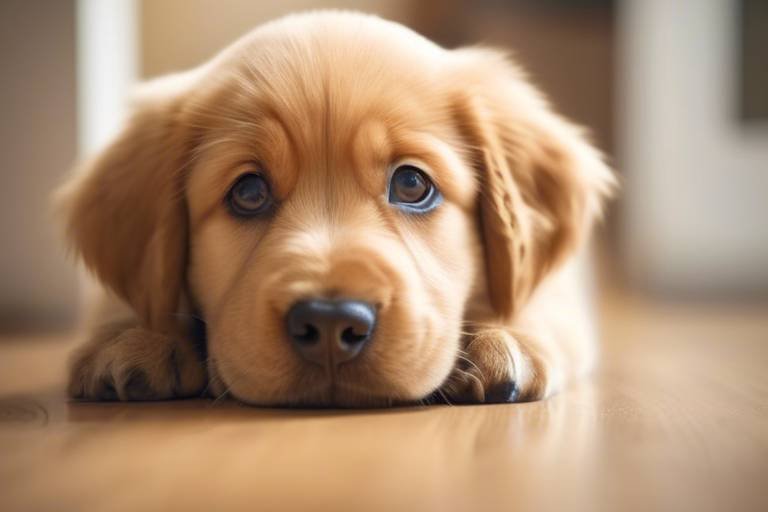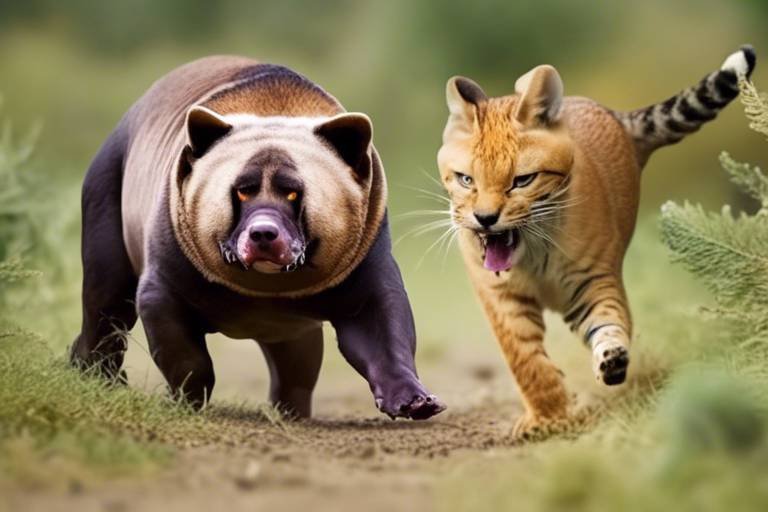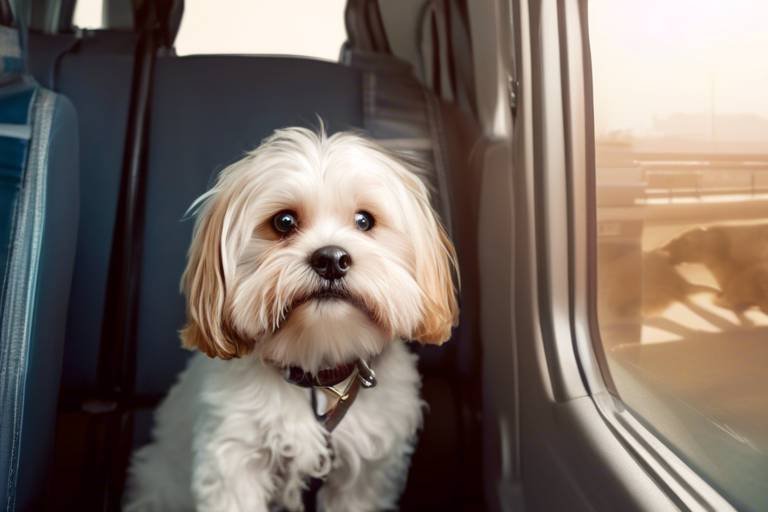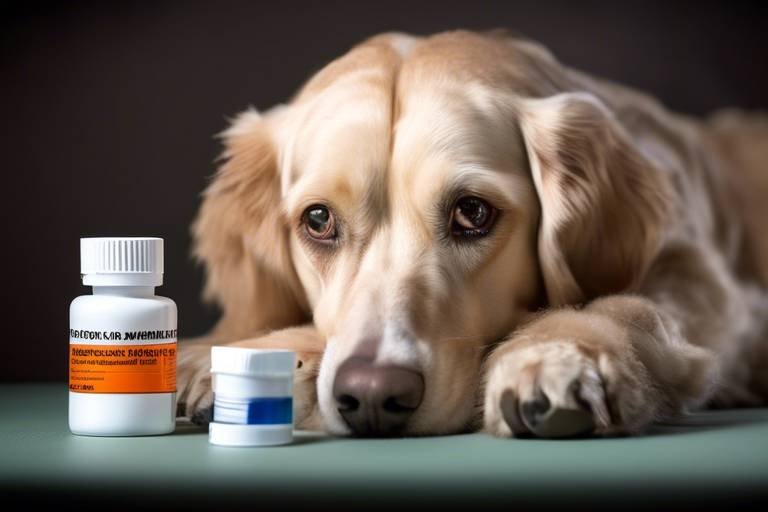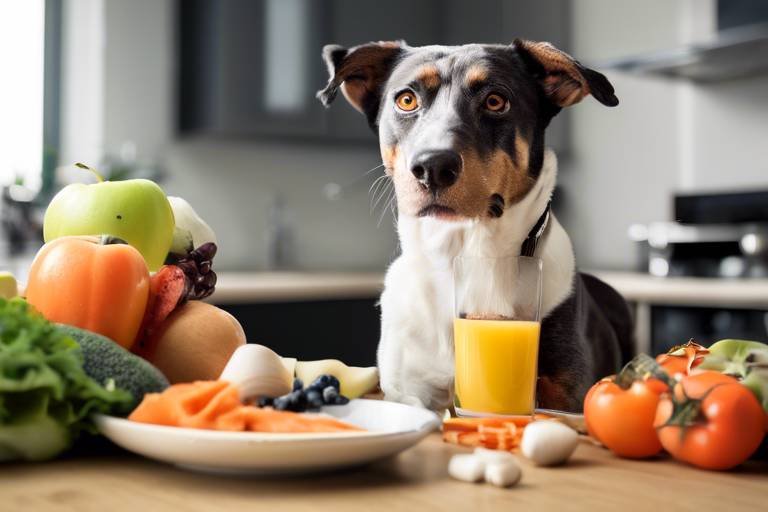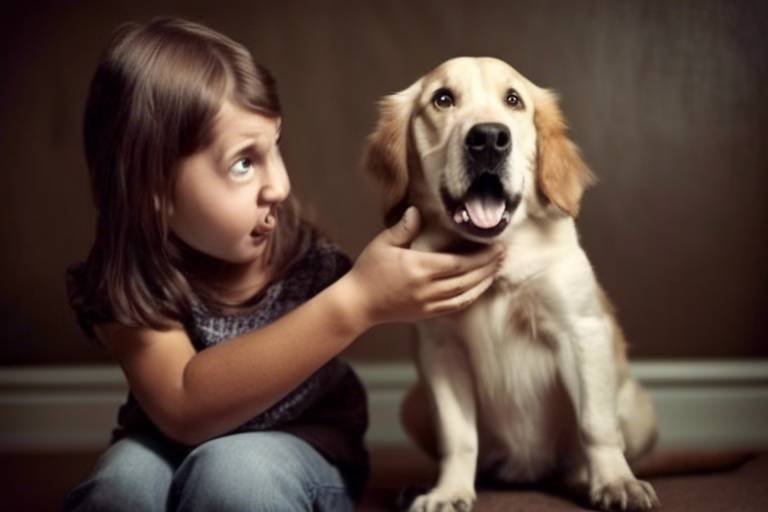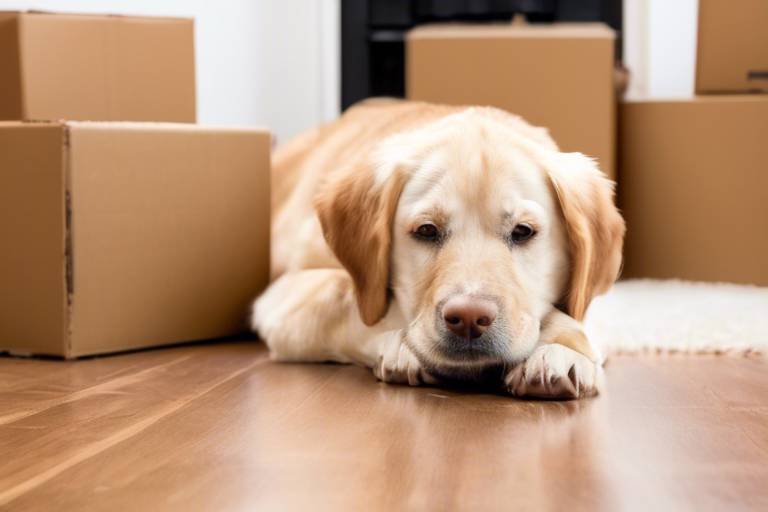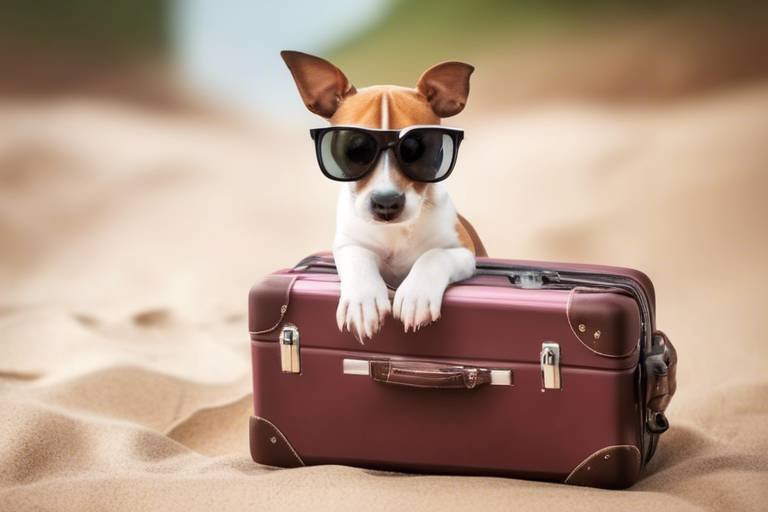How to Make Your Home Pet-Safe
As a pet owner, ensuring that your home is a safe haven for your furry friends is not just a responsibility but a labor of love. Imagine your beloved dog or cat exploring every nook and cranny of your home, tail wagging or purring contentedly, without a care in the world. However, the reality is that many household items and conditions can pose serious risks to pets. From toxic plants to hazardous chemicals, the dangers can be lurking around every corner. This article delves into essential tips and strategies to transform your living space into a pet-safe environment. Let's embark on this journey to create a sanctuary where your pets can thrive, explore, and play without fear!
Understanding potential dangers in your home is the first step to making it pet-safe. Many items that humans use daily can be harmful or even fatal to pets. For instance, did you know that certain common plants are toxic to dogs and cats? Here are some examples of hazards you should be aware of:
- Toxic Plants: Lilies, azaleas, and sago palms are just a few examples of houseplants that can be deadly to pets.
- Chemicals: Cleaning supplies, antifreeze, and certain human medications can be extremely toxic if ingested.
- Sharp Objects: Items like scissors, needles, and broken glass can cause injuries if your pet gets too curious.
By recognizing these hazards, you can take proactive steps to eliminate or minimize the risks, ensuring a safer environment for your pets.
Pet-proofing involves rearranging furniture and securing items that could be dangerous. Think of it as creating a safe playground for your pets. Start by assessing your home from a pet’s point of view. What looks like fun to you might be a perilous adventure for your pet. Here are some practical tips on how to create a safe space:
- Keep small items out of reach, as pets are notorious for chewing on anything they can find.
- Rearrange furniture to create open spaces where pets can move freely without the risk of bumping into sharp corners.
Cords and wires can pose a choking hazard or lead to electric shock. Pets are naturally curious and may chew on these items, which can lead to serious injuries. To keep your pets safe, consider the following effective ways to conceal and secure cords:
Cord covers are an excellent solution for protecting your pets from dangerous wires. They come in various styles and materials, offering both protection and aesthetics. By encasing your cords in these covers, you can prevent your pets from chewing on them and reduce the risk of electrical accidents.
Proper organization of cables can minimize risks. Use cable ties or clips to bundle cords together and secure them out of reach. This not only keeps your space looking tidy but also reduces the chance of your pet getting tangled or chewing on them.
Many childproofing products can also protect pets. Think of baby gates, cabinet locks, and outlet covers as your allies in creating a safe environment. Baby gates can keep pets out of certain rooms or areas where they might get into trouble. Cabinet locks can prevent pets from accessing harmful substances stored beneath the sink or in other cabinets.
Many common cleaning products contain harmful chemicals. While keeping your home clean is essential, it shouldn't come at the expense of your pet's safety. Opt for pet-safe alternatives that are effective yet gentle on your furry friends. Always check labels for the following:
- Non-toxic ingredients
- Natural fragrances
- Biodegradable components
Reading labels is crucial when selecting cleaning products. Look for certifications or brands that specifically state they are pet-safe. This small step can save your pet from potential harm and keep your home sparkling clean.
Creating your own cleaning solutions can be both safe and effective. Here are a couple of simple recipes for homemade cleaners that are safe for pets while still maintaining cleanliness in your home:
1. All-Purpose Cleaner: - 1 cup of white vinegar - 1 cup of water - A few drops of essential oil (like lavender or lemon) 2. Pet Stain Remover: - 1 cup of baking soda - 1 cup of water - A few drops of dish soap
These DIY solutions not only keep your home clean but also ensure that your pets are safe from harmful chemicals.
Q: What common household items are toxic to pets?
A: Items like chocolate, grapes, certain plants (like lilies), and cleaning products can be toxic. Always research before introducing new items into your home.
Q: How can I tell if a cleaning product is safe for pets?
A: Look for labels that indicate the product is non-toxic, pet-safe, and free from harmful chemicals. It's always best to err on the side of caution.
Q: Are there any pet-proofing products I should consider?
A: Yes! Baby gates, cord covers, and cabinet locks are excellent choices for pet-proofing your home.

Identifying Common Household Hazards
Making your home a safe haven for your pets starts with identifying potential hazards lurking in your living space. You might think your home is a cozy retreat, but it could also be a minefield for your furry friends. From toxic plants to harmful chemicals, understanding what dangers exist is crucial. Let’s dive into some of the most common household hazards that could threaten your pets' safety.
First up on the hazard list are toxic plants. Many common houseplants, such as lilies, philodendrons, and pothos, can be extremely harmful to pets if ingested. Even some seemingly harmless plants can cause gastrointestinal upset, lethargy, or worse. It's essential to research any plants you bring into your home and consider opting for pet-safe alternatives like spider plants or Boston ferns.
Next, we have household chemicals. Cleaning products, pesticides, and even certain air fresheners can contain substances that are toxic to pets. For instance, many cleaners have ingredients like bleach or ammonia that can be dangerous if ingested or inhaled. Always store these products out of reach and look for pet-safe cleaning alternatives when possible. Remember, just because a product smells nice doesn’t mean it’s safe for your furry companions!
Another hazard that often goes unnoticed is sharp objects. Items like scissors, knives, and even broken glass can pose serious risks to curious pets. It’s essential to keep these items securely stored in cabinets or drawers. Additionally, be mindful of small objects that could be swallowed, such as coins, buttons, or toys with small parts. A simple rule of thumb is: if it can fit in your pet’s mouth, it should be out of their reach!
Lastly, let’s not overlook the electrical hazards. Cords and wires can be particularly enticing for pets, especially for those who love to chew. Exposed wires can lead to electric shock, which can be life-threatening. Keeping cords secured and out of reach is crucial. You might even consider using cord covers or hiding them behind furniture to minimize the risk.
To summarize, here’s a quick overview of common household hazards:
- Toxic plants: Research plants before bringing them home.
- Household chemicals: Store them safely and choose pet-friendly options.
- Sharp objects: Keep scissors, knives, and small items secured.
- Electrical hazards: Conceal cords and wires to prevent chewing.
By being aware of these common hazards, you’re taking the first step in creating a pet-safe environment. Remember, prevention is always better than cure. Keep an eye out for these dangers, and you’ll be well on your way to ensuring your home is a safe and welcoming space for your beloved pets.

Pet-Proofing Your Living Space
This article explores essential tips and strategies for ensuring your home is a safe environment for pets, covering common hazards and preventative measures to protect your furry friends.
Understanding potential dangers in your home is the first step to making it pet-safe. This section highlights common hazards like toxic plants, chemicals, and sharp objects that can harm pets.
Pet-proofing your living space is not just about removing dangerous items; it’s about creating an environment where your furry friends can explore without worry. Think of your home as a playground, but one that needs to be safe and secure. Rearranging furniture, securing loose items, and being mindful of your pet’s natural curiosity can go a long way in preventing accidents.
Start by identifying areas that are particularly hazardous. For instance, if you have a curious puppy or an adventurous kitten, certain rooms may need extra attention. Consider using baby gates to restrict access to areas like the kitchen or laundry room where dangerous items might be stored. This not only protects your pets but also gives you peace of mind when you're busy with other tasks.
Cords and wires can pose a choking hazard or lead to electric shock, making them a significant concern for pet owners. Imagine your pet’s excitement as they see a wiggly cord—it's an invitation to play! To prevent any accidents, it’s essential to conceal and secure these items effectively. Start by using cord clips to attach wires to walls or furniture, keeping them out of reach.
Cord covers are an excellent solution for protecting your pets from dangerous wires. They not only hide the cords but also make it less tempting for your pets to chew on them. There are various types of cord covers available, such as:
- Flexible Cord Covers: These can be shaped around furniture and walls, providing a snug fit.
- Hard Plastic Covers: These offer robust protection and are ideal for high-traffic areas.
- Fabric Covers: These are soft and can blend in with your decor while still providing protection.
Proper organization of cables can minimize risks. By bundling and securing cables with ties or clips, you can reduce the chance of your pet getting tangled or chewing on them. Think of it as creating a neat little bundle of joy instead of a chaotic mess. You can also place cable management boxes on the floor to keep cables hidden and organized, which not only looks better but also keeps your pets safe.
Many childproofing products can also protect pets. Baby gates are not just for toddlers; they can be a great way to keep pets in designated areas. Additionally, cabinet locks can prevent pets from accessing harmful substances like cleaning supplies or medications. Think of these tools as your secret weapons in the battle for a safe home. They can help you create a pet-friendly environment without sacrificing your home's aesthetics.
Many common cleaning products contain harmful chemicals. This section emphasizes the importance of selecting pet-safe alternatives to ensure a clean yet safe home for your pets.
Reading labels is crucial when selecting cleaning products. This part explains how to identify pet-safe products and what to look for to avoid harmful substances.
Creating your own cleaning solutions can be both safe and effective. This subsection provides recipes for homemade cleaners that are safe for pets while still maintaining cleanliness in your home.
Q: How can I tell if a plant is toxic to my pet?
A: Check resources like the ASPCA's list of toxic plants or consult your veterinarian for guidance.
Q: Is it safe to use essential oils around pets?
A: Many essential oils can be harmful to pets. Always research specific oils and consult your vet before use.
Q: What should I do if my pet chews on a cord?
A: If your pet chews on a cord, assess the situation immediately. If they show signs of distress, contact your vet right away.
Q: Are there any specific cleaning products I should avoid?
A: Avoid products with ammonia, bleach, and other harsh chemicals. Look for eco-friendly or pet-safe labels.
Securing Cords and Wires
When it comes to creating a pet-safe home, one of the most overlooked areas is the multitude of cords and wires that can be found in almost every household. These seemingly innocuous items can present significant dangers to our furry friends. Imagine a curious puppy or kitten, drawn to the dangling cords like moths to a flame. They might see them as toys, but the reality is that these cords can cause choking hazards or even electric shock. Therefore, it’s vital to take proactive steps in securing these items to ensure your pets remain safe and sound.
First and foremost, you should assess your living space for any exposed cords. Look behind your entertainment center, under your desk, and near any electronic devices. Once you identify these areas, consider utilizing cord covers. These protective sleeves can be a game changer in preventing your pets from accessing dangerous wires. Not only do they keep cords organized, but they also provide a barrier that discourages chewing. Cord covers come in various materials, including plastic and fabric, so you can choose one that best suits your home decor.
In addition to cord covers, another effective strategy is to bundle and secure cords. You can use cable ties or clips to group cords together, reducing the number of loose wires that can tempt your pets. This organization not only minimizes the risk of tangling but also keeps the area looking tidy. When bundling, ensure that the cords are secured tightly but not so tightly that they might be damaged or cause any strain on the connections. You might even consider using decorative boxes or baskets to hide cords from view while still maintaining easy access for plugging and unplugging devices.
Additionally, think about the layout of your furniture. Rearranging your space can make a significant difference in cord safety. For example, placing furniture strategically can block access to cords that run along the floor. If you have a particularly adventurous pet, consider using furniture with built-in cord management systems. This way, you can keep cords hidden and out of reach while still enjoying the functionality of your electronic devices.
Lastly, it’s essential to regularly inspect your cords and wires for any signs of wear or damage. Pets can unknowingly contribute to the deterioration of cords, so keeping an eye on them can prevent accidents before they happen. If you notice any fraying or exposed wires, replace them immediately. Remember, a little vigilance goes a long way in protecting your beloved pets.
By implementing these simple yet effective strategies, you can significantly reduce the risk of your pets encountering dangerous cords and wires. After all, a safe home is a happy home, and ensuring your furry friends can roam freely without the threat of injury is one of the best gifts you can give them.
Using Cord Covers
When it comes to making your home a safe haven for your furry friends, one of the most overlooked hazards is the multitude of cords and wires that snake across our living spaces. These cords can pose serious risks, from choking hazards to potential electric shocks. That's where cord covers come into play. Think of cord covers as the protective armor your home needs to keep your pets safe from those tempting, dangling wires that seem to call out to them.
Cord covers come in various styles and materials, designed to blend seamlessly into your home décor while providing an essential layer of protection. You can find options made from plastic, fabric, or even rubber, each offering unique benefits. For instance, plastic cord covers are often easy to install and can be painted to match your walls, making them a discreet yet effective solution. On the other hand, fabric covers can add a touch of style and warmth to your space, all while keeping those cords tucked away and out of reach.
Here are some key benefits of using cord covers:
- Prevents Chewing: Pets, especially puppies and kittens, love to chew on anything they can find. Cord covers act as a barrier, making it less enticing for them to nibble on those dangerous wires.
- Reduces Tangling: With cords neatly tucked away, you minimize the risk of your pets getting tangled in them, which can lead to accidents or injuries.
- Enhances Aesthetic: Cord covers can help maintain a clean and organized look in your home, reducing clutter and making your space feel more inviting.
When selecting cord covers, consider the layout of your home and the types of cords you need to cover. For instance, if you have a lot of electronic devices in your living room, you might want to invest in a more robust cord management system that includes multiple channels for different cables. Additionally, ensure that the covers are easy to install and remove, as you may need to access the cords for maintenance or adjustments.
In conclusion, using cord covers is a simple yet effective way to enhance the safety of your home for your pets. By taking this proactive step, you not only protect your furry companions from potential hazards but also create a more organized and visually appealing living space. Remember, a little effort goes a long way in ensuring your home is a safe haven for your beloved pets!
Organizing Cables
When it comes to keeping our furry friends safe, one often overlooked area is the organization of cables and wires throughout our homes. Just think about it: those tangled cords lying around can be an irresistible temptation for pets, especially curious kittens and playful puppies. Not only can they get tangled up in them, but they can also chew on them, which could lead to dangerous situations like electric shock or choking. So, how can we effectively organize our cables to minimize these risks?
First and foremost, it’s essential to assess your space. Take a good look around your home and identify where the most vulnerable cables are located. This could be behind your entertainment center, under your desk, or even in the kitchen. Once you’ve pinpointed these areas, you can start implementing some practical solutions to keep those cables out of reach.
One effective method is to use cable management systems. These are specially designed tools that can help you bundle and secure your cables neatly. For instance, you can use cable ties or clips to group cords together, which not only minimizes clutter but also makes it harder for your pet to access them. Additionally, consider using cable sleeves or cord covers to shield the wires from curious little paws. These covers can be found in various materials and colors, allowing you to maintain an aesthetically pleasing look in your home while ensuring safety.
Another tip is to run cables along walls or behind furniture. This can significantly reduce the chances of your pets getting tangled in them. If possible, try to keep cords high up, out of your pet's reach. For example, you could use adhesive hooks to secure cables along the walls, keeping them neatly organized and away from your pet’s curious nature.
In addition to these methods, consider creating a designated pet-free zone for areas where you have a lot of cables, such as your home office or entertainment center. Baby gates can be a great way to restrict access to these areas, ensuring that your pets stay safe while you work or relax. This not only protects your pets but also helps you maintain a tidy living space.
Finally, don’t forget to regularly check your cables for any signs of wear and tear. If you notice any frayed wires or damaged cords, it’s crucial to replace them immediately. Not only can damaged cables be hazardous to your pets, but they can also pose a risk to your electronics and home. Remember, a little effort in organizing and securing cables can go a long way in creating a safe environment for your beloved pets.
Childproofing Elements for Pets
When it comes to making your home a haven for your furry friends, childproofing elements can be a game-changer. Many of the products designed to keep children safe can also work wonders for your pets. Think about it: if a product can prevent a toddler from opening a cabinet filled with cleaning supplies, it can certainly keep your curious pet out of trouble! The idea is to create a space where your pets can explore freely without the risk of encountering hazards.
One of the most effective tools in your pet-proofing arsenal is the baby gate. These gates are perfect for creating boundaries within your home. For instance, if you want to keep your dog out of the kitchen while you’re cooking up a storm, a sturdy baby gate can do the trick. They come in various sizes and materials, so you can choose one that fits your home’s aesthetic while keeping your pets safe. Just ensure that the gate is tall enough to prevent jumping, as some pets are quite the acrobats!
Another essential item to consider is cabinet locks. Just like children, pets are naturally curious and will explore every nook and cranny of your home. Installing cabinet locks on lower cabinets can prevent your pets from accessing harmful substances like cleaning supplies or sharp objects. There are various types of locks available, from magnetic locks to sliding locks, so you can pick one that suits your needs best. Remember, a little prevention goes a long way in ensuring your pet's safety.
Additionally, consider using furniture anchors to secure heavy items that could topple over if your pet decides to climb or jump onto them. This is especially important for households with larger dogs or playful kittens. By anchoring bookshelves, dressers, and other heavy furniture to the wall, you can prevent accidents that might occur if your pet gets a little too adventurous.
To summarize, here are some key childproofing elements that can help keep your pets safe:
- Baby Gates: To restrict access to certain areas.
- Cabinet Locks: To keep harmful substances out of reach.
- Furniture Anchors: To prevent heavy items from tipping over.
By implementing these childproofing strategies, you’re not just safeguarding your pets; you’re also creating a more organized and secure living space. It's all about being proactive and thinking ahead. After all, a little effort can lead to a much happier and safer environment for your furry companions!
Q: Can I use regular baby gates for larger dogs?
A: While some baby gates can handle larger dogs, it's best to look for gates specifically designed for larger breeds to ensure they can withstand the pressure.
Q: Are there pet-proofing products that can also be used for children?
A: Absolutely! Many childproofing products, like cabinet locks and corner protectors, are effective for pets as well.
Q: How do I know which cleaning products are safe for pets?
A: Always check the labels for warnings about pets and look for products labeled as "pet-safe" or "non-toxic."

Choosing Pet-Safe Cleaning Products
When it comes to keeping our homes clean, we often overlook the potential dangers lurking in our cleaning supplies. Many common cleaning products contain harsh chemicals that can be harmful to our furry friends. This is why choosing pet-safe cleaning products is crucial for maintaining a safe environment. But how do you know which products are safe and which ones could pose a risk? It all starts with understanding labels and ingredients.
Many cleaning products are marketed as effective and easy to use, but they can contain substances that are toxic to pets. For example, products with ammonia, bleach, and certain essential oils can be particularly dangerous. It's essential to read the labels carefully and look for products that explicitly state they are safe for pets. If a product doesn't mention pet safety, it's best to steer clear. In fact, here are some common ingredients to avoid:
- Ammonia
- Chlorine bleach
- Phenols
- Alcohol
- Essential oils like tea tree, eucalyptus, and citrus
But don’t worry! There are plenty of pet-safe alternatives available on the market today. Many brands have recognized the need for safer cleaning options and have developed products that are both effective and non-toxic to pets. Look for labels that say “non-toxic,” “pet-friendly,” or “biodegradable.” These products are designed to clean your home without putting your pets at risk.
Another great option is to make your own cleaning solutions at home. Not only is this often more cost-effective, but it also allows you to control the ingredients. Here are a few simple recipes for DIY cleaning solutions that are safe for pets:
| Cleaning Solution | Ingredients | Use |
|---|---|---|
| All-Purpose Cleaner | 1 cup vinegar, 1 cup water | Perfect for countertops and surfaces. |
| Baking Soda Scrub | 1 cup baking soda, water to form a paste | Great for scrubbing tough stains. |
| Pet Odor Eliminator | 1 cup vinegar, 1 cup water, a few drops of dish soap | Effective for neutralizing pet odors. |
By using these safe cleaning methods, you can maintain a clean home without worrying about the health of your pets. Moreover, it's always a good idea to ensure that your cleaning routine allows for proper ventilation. Open windows and doors to let fresh air circulate, which helps dissipate any lingering odors or fumes from cleaning products.
In conclusion, being mindful of the cleaning products you use is an essential part of creating a pet-safe home. By choosing pet-safe options and considering DIY solutions, you can keep your living space clean and your pets safe. Remember, a little awareness goes a long way in ensuring that your furry companions are not only happy but also healthy!
Q: What are the signs that a cleaning product is toxic to pets?
A: Signs include drooling, vomiting, difficulty breathing, or lethargy after exposure. If you suspect poisoning, contact your veterinarian immediately.
Q: Are all natural cleaning products safe for pets?
A: Not necessarily. While many natural products are safer, some can still be harmful. Always check labels and research ingredients.
Q: Can I use essential oils for cleaning if I have pets?
A: Some essential oils can be toxic to pets. It's crucial to research specific oils and consult with a veterinarian before use.
Q: How can I safely store cleaning products in a pet-friendly home?
A: Always store cleaning products in high cabinets or locked areas out of reach of pets. Consider using childproof locks for added safety.
Understanding Labels
When it comes to keeping your furry friends safe, understanding the labels on cleaning products is crucial. Many pet owners often overlook this aspect, assuming that all household cleaners are harmless. Unfortunately, that's not the case! Some seemingly innocent products can contain toxic chemicals that could pose serious health risks to your pets. So, what should you look for on those labels? First and foremost, watch out for ingredients like phenols, ammonia, and bleach. These substances can cause a range of issues from skin irritation to respiratory problems.
Moreover, many products are marketed as “natural” or “green,” which can be misleading. Just because a product is labeled as eco-friendly doesn’t mean it’s safe for pets. Always look for specific certifications or labels that indicate a product is pet-safe. For example, you might see a label that states “non-toxic” or “safe for pets.” These are good indicators that the product is less likely to harm your beloved companions.
To make it easier for you, here’s a quick guide on how to interpret cleaning product labels:
| Label Type | Meaning |
|---|---|
| Non-Toxic | Generally safe for pets and humans when used as directed. |
| Pet Safe | Specifically formulated to be safe for animals. |
| Natural | May contain natural ingredients, but check for harmful additives. |
| Warning | Contains hazardous materials; should be kept away from pets. |
In addition to reading labels, it's also a good idea to do some research on the brands you use. Many companies provide detailed information about their ingredients on their websites. Don't hesitate to reach out to customer service if you have questions about specific products. Remember, being proactive is key to ensuring a safe environment for your pets!
Lastly, consider making your own cleaning solutions. Not only can this be a fun DIY project, but it also allows you to control every ingredient that goes into your cleaners. Simple ingredients like vinegar, baking soda, and lemon juice can work wonders for cleaning without posing a risk to your pets. Your home can be both clean and safe, and understanding labels is the first step toward achieving that balance!
- What are some common toxic ingredients in cleaning products? Many cleaning products contain ammonia, bleach, and phenols, which can be harmful to pets.
- How can I tell if a product is safe for pets? Look for labels that say "non-toxic" or "pet safe." Always read the ingredients list carefully.
- Can I use homemade cleaning solutions around my pets? Yes! Homemade cleaners made from vinegar, baking soda, and lemon juice are generally safe and effective.
DIY Cleaning Solutions
Creating your own cleaning solutions is not only a fantastic way to ensure a pet-safe environment, but it can also save you money and reduce the number of harsh chemicals in your home. Many store-bought cleaners are packed with substances that can be harmful to your furry friends, but with a few simple ingredients, you can whip up effective and safe alternatives right in your kitchen! Imagine having a sparkling clean home without the worry of your pets getting into something toxic. Sounds great, right?
To get started, you’ll need to gather some common household ingredients that are not only safe for pets but also powerful enough to tackle dirt and grime. Here are some essential ingredients you might want to keep on hand:
- Baking Soda: A natural deodorizer and stain remover.
- White Vinegar: Excellent for cutting through grease and eliminating odors.
- Castile Soap: A gentle soap that’s effective for cleaning surfaces.
- Essential Oils: Some are safe for pets and can add a pleasant scent (like lavender or chamomile). However, be cautious with essential oils, as some can be harmful to pets.
Here are a couple of simple recipes to get you started:
| Cleaning Solution | Ingredients | Instructions |
|---|---|---|
| All-Purpose Cleaner | 1 cup white vinegar, 1 cup water, 1 tablespoon Castile soap | Mix all ingredients in a spray bottle. Shake well before use. Spray on surfaces and wipe clean with a cloth. |
| Baking Soda Carpet Cleaner | 1 cup baking soda, a few drops of essential oil (optional) | Combine baking soda and essential oil in a bowl. Sprinkle on carpets, let sit for 15 minutes, then vacuum. |
These DIY cleaning solutions are not only effective but also allow you to have peace of mind knowing that your pets are safe. Plus, you can customize the scents and ingredients to suit your preferences! Just imagine the satisfaction of knowing you’ve made a cleaner that’s not only good for your home but also for your beloved pets.
Before you dive in, always remember to test any new cleaning solution on a small, inconspicuous area first. This way, you can ensure that it won’t damage your surfaces. And, while these solutions are pet-safe, it’s always a good idea to keep your pets away from freshly cleaned areas until they are completely dry. After all, we want to keep our furry companions safe and sound!
So, roll up your sleeves, get your ingredients ready, and start creating your own pet-safe cleaning products! Not only will your home be clean, but you’ll also be contributing to a healthier environment for your pets and family.
Frequently Asked Questions
- What are some common household hazards for pets?
Common household hazards for pets include toxic plants, chemicals found in cleaning products, sharp objects, and small items that can be swallowed. It's essential to identify these dangers to create a safe environment for your furry friends.
- How can I pet-proof my living space effectively?
Pet-proofing your living space involves rearranging furniture to eliminate hazards, securing items that could fall, and using baby gates to restrict access to dangerous areas. It's all about creating a space where your pets can roam freely without getting into trouble!
- Are cord covers really effective in keeping pets safe?
Absolutely! Cord covers are an excellent solution for protecting pets from dangerous wires. They help prevent chewing and reduce the risk of electric shock, making your home a much safer place for your furry companions.
- What should I look for when choosing pet-safe cleaning products?
When selecting cleaning products, always read the labels. Look for terms like "non-toxic," "pet-safe," or "biodegradable" to ensure the product won't harm your pets. Avoid products containing bleach, ammonia, or other harmful chemicals.
- Can I make my own pet-safe cleaning solutions?
Yes! DIY cleaning solutions can be both safe and effective. Simple ingredients like vinegar, baking soda, and water can create powerful cleaners without the harmful chemicals found in many store-bought products. Just be sure to test any new solution in a small area first!

